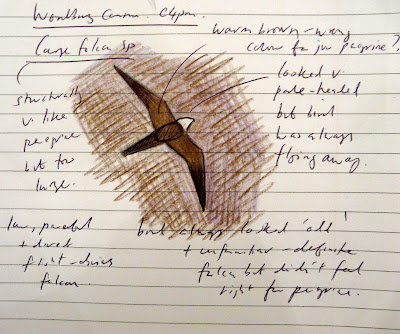Orcombe Point at dawn - cue Pigeons!
It didn't get going immediately this morning, but when it did it was truly spectacular. A conservative count of c20,000 Woodpigeon, mostly before 0815, was made, but to be honest the flocks were so big that it could have been considerably more. It was a bit like that moment on 'Zulu' when the horizon is scanned to reveal an overwhelming number of warriors silhouetted against the horizon. At times, Nick and I literally couldn't see the end of the flocks! The movement seemed to dry up at 0815, but as we were getting back in to our cars, at 9am, another big wave went over west. All flocks were higher up today, in windless conditions, and none were observed off the coast.
Also this morning - 1 Purple Sandpiper (Maer Rocks), 2 Stonechat, c20+ Chaffinch, 3+ Brambling, 12+ Skylark, 9 Fieldfare, 2+ Reed Bunting and 30+ Starling.
Mudbank produced the Black Brant, 1 Pale-bellied Brent Goose, 2 Grey Plover, 13 Red-breasted Merganser, 2 Goldeneye and 7 Great Crested Grebe.
Finally, I managed to check the local Cirl Bunting feeding station. No Cirls today but 4+ Yellowhammer, 2+ Reed Bunting, 1 Redpoll, c15+ Linnet, 1+ Goldfinch, c5+ Greenfinch, c50+ Chaffinch and, best of all, 1+ Brambling. Also 1 Redwing, 1 Fieldfare and c100+ Woodpigeon. The field next to the feeding field is currently stubble, so it's going to be worth keeping an eye on it over the winter.
I've strongly adjusted the contrast on this photo so that the Pigeons stand out more. This was fairly typical of a number of flocks that swept over. All Nick and I could do was shrug our shoulders and make rough guesses!
Black Brant - Mudbank.
The long-staying adult Pale-bellied Brent Goose.
Grey Plover - a treat to see them up close. Grey Plovers normally stick to the middle of the estuary.



























































